Four-Wave Mixing in Atomic Vapour
Many quantum communication protocols require entangled states of distant qubits. While the preparation of entangled photonic qubits is well established, it is sometimes important to transfer this entanglement to stationary qubits, such as atoms. For such process to be efficient, one needs entangled photons with a frequency bandwidth matching the absorption profile of the atoms.
Conventional sources based on down conversion in nonlinear optical crystals usually have a bandwidth that is a few orders of magnitude larger than lifetime limited atomic absorption lines. An alternative approach to generate narrowband entangled photons exploits the four-wave mixing (FWM) process in an atomic ensemble, in which the frequency bandwidth of the pairs is determined by the dispersion of the vapor, and can be narrow enough to match the atomic absorption profile.
Top | Principle of four-wave mixing | Experimental setup | Time correlation of photon pairs | Thermal Light | Idler Bandwidth | Optical density vs Bandwidth | Homodyne measurement | Envelope reversal | Quantum beats | References
Four-wave mixing principle
Signal and idler photons can be generated via four-wave mixing of two strong pump laser beams P1 and P2 by meeting the phase-matching condition KP1 + KP2 = KS + KI and energy conservation, ωP1 + ωP2 = ωS + ωI
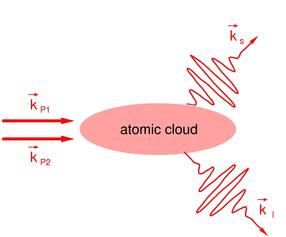 |
 |
It was earlier shown that it is possible to obtain narrowband correlated photon pairs from atomic vapour [4-5]. One of the possible schemes exploits near-resonant interaction in a diamond configuration with cold 87Rb vapor confined in magneto-optical trap (MOT).
The atomic ensemble is excited from 5S1/2 to 5D3/2 via a two-photon transition performed by two pump beams of wavelength 780nm and 776nm. The atomic decay from the excited state through the intermediate state 5P1/2 back to the same initial ground state 5S1/2 produces a pair of correlated photons if the phase matching condition is met.
Experimental Setup
Due to atomic dispersion, signal and idler photons can be observed at small angles with respect to the propagation direction of pump laser beams. Our setup employs such a configuration:

Two linearly polarized pump beams (H and V) impinge at an angle of 0.5o onto cold 87Rb atoms confined in a MOT (optical density ~ 32). Narrowband interference filters (F3, F4) and polarizers (P3, P4) select photons that satisfy conservation of angular momentum. A solid etalon E is used to supress the uncorrelated idler photons indicated by dashed line in the level scheme.
Time Correlation of photon pairs
Photodetection events in signal and idler modes on Silicon avalanche photodiodes (APD) show a strong correlation in time, an indication for the photon pair generation process.
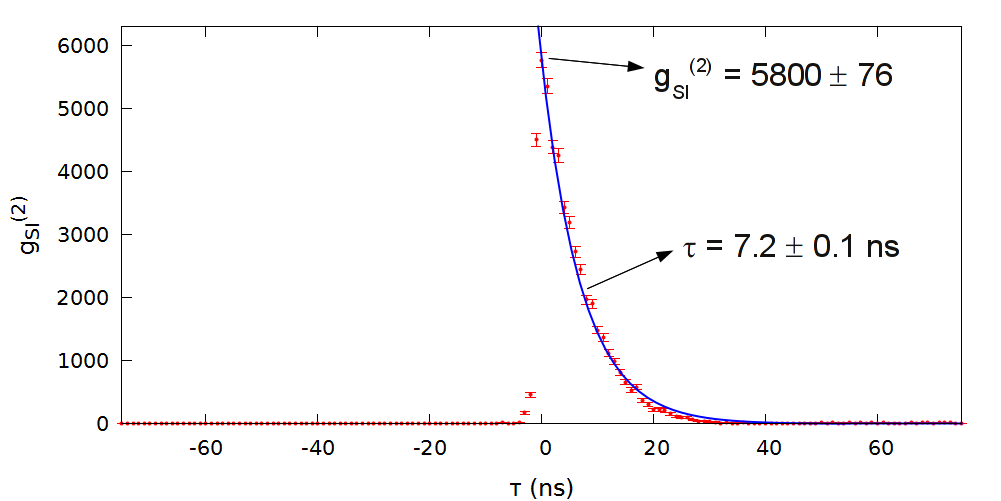
The photon coincidences as a function of the time delay τ in this measurement were recorded over 612 sec. The normalized second order correlation function g(2) peaks at about 5800, with an asymmetric shape. The 1/e decay time of 7.2 ns is shorter that the lifetime of the intermediate state 5P1/2 (27 ns) due to superradiance. We observe photon pair rate of upto 7700 per second with pairs to singles ratio (efficiency) of 14.9% for signal and 23% for idler.
Thermal Light
A Hanbury Brown-Twiss-style experiment, where photons in each signal or idler mode are distributed on two photodetectors, and the photoevent timing stucture is recored, reveals the thermal nature of the parametric fluorescence in each mode
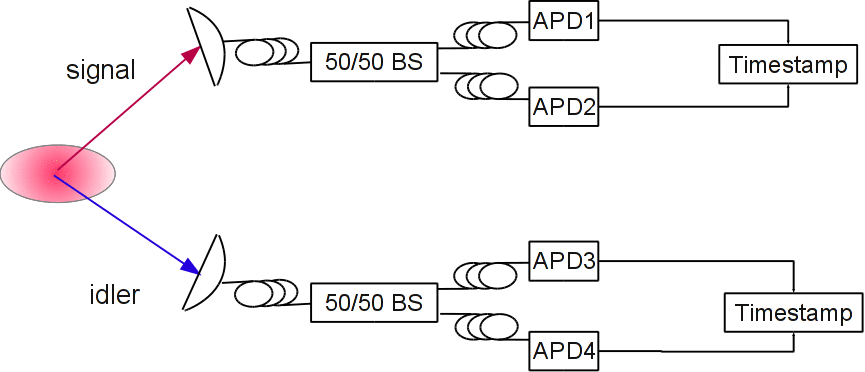
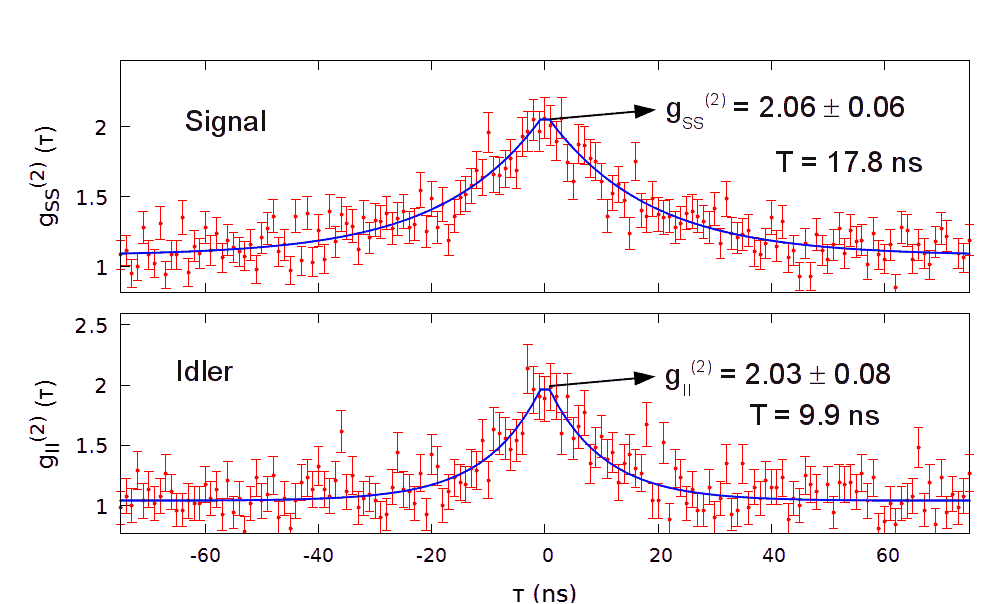
For time difference τ=0 between the photodetection events, the normalized correlation function reaches g(2)(τ=0)≈2, the value expected from textbooks for thermal states.
Idler Photon Bandwidth
The optical bandwidth of signal and idler photons are very narrow, determined by the atomic transition, and collective effects in the atomic ensemble. We measured the bandwidth of both modes with a scanning Fabry-Perot resonator:
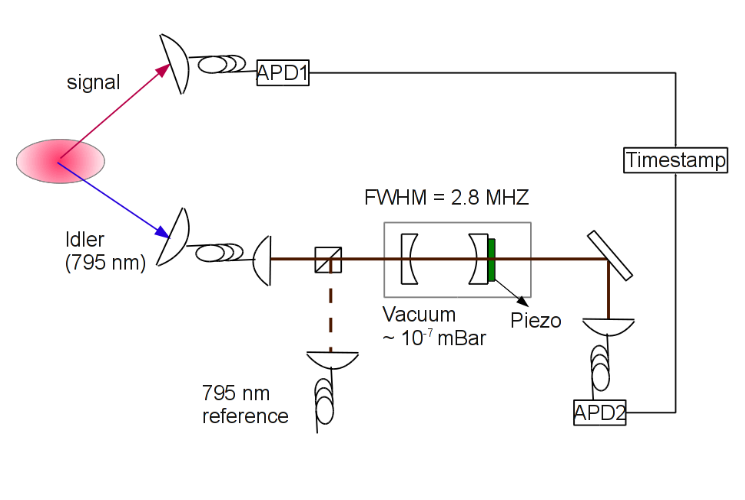

Within our expermimental accuracy, the observed bandwidth of 24.7 MHz of the idler mode for a given optical density is consistent with the transform limited bandwidth of 22.3 MHz obtained from the inverse decay time constant of g(2)(τ).
Optical Density vs Bandwidth
The idler bandwidth can be tuned by varying the optical density of the cloud due to superradiance:
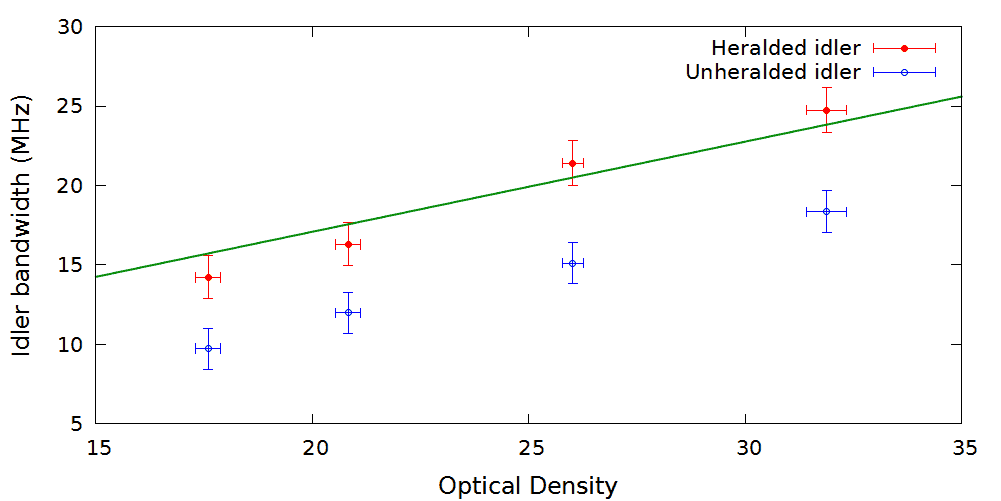
The solid line is from a theoretical model, which qualitatively describes the dependency of the bandwidth from the optical density.
Optical Field Quadrature of heralded signal photons
Photons generated with such a scheme have such a narrow bandwidth that their temporal envelope can be measured not only by time-resolved detection with avalanche photodetectors, but also continuous photodetectors in a so-called homodyne measurement. There, the optical field quadrature are recorded with the aid of a local oscillator and a photodiode pair. Such a measurement reveals an exponential rising field for the heralded signal photons:
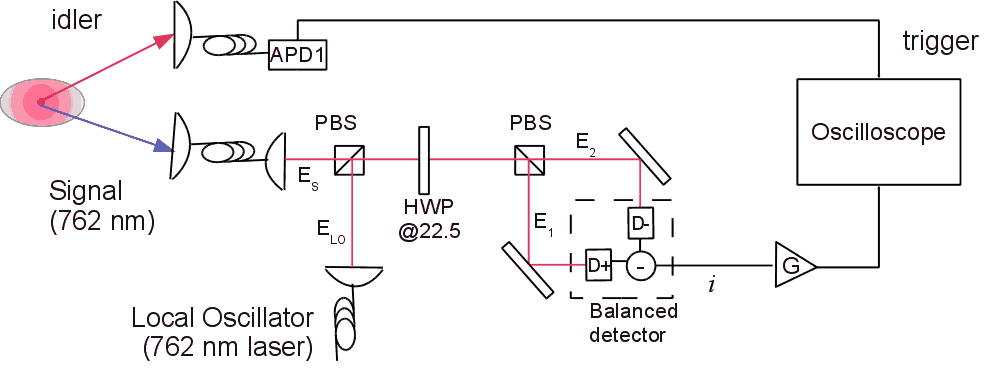
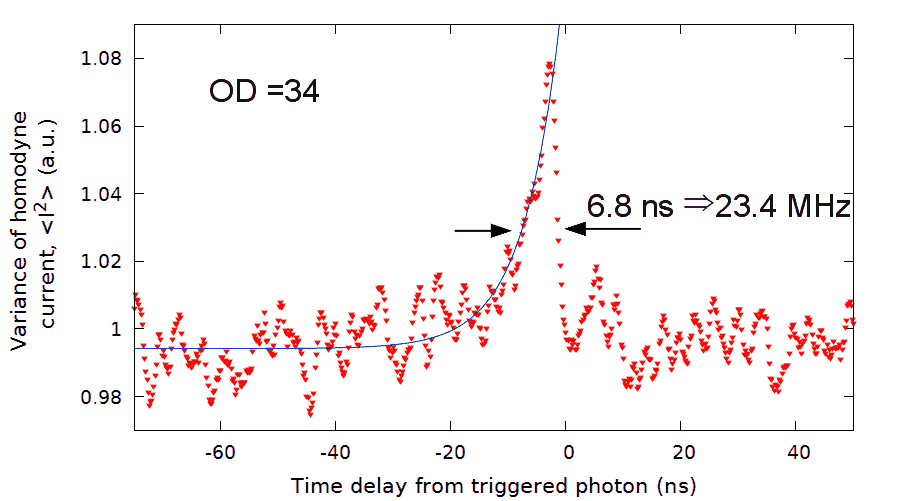
When measuring the field quadrature of the upper branch (signal), triggered by a detection on the lower (idler) branch photon, we observe the ''counterintuitive'' shape of a rising exponential envelope for a single signal photon [7]. While this envelope would be ideal for a re-absotption by a single atom in the spirit of an inverted spontaneous emission, such an experiment would be hard because the photon would not drive an atomic transition starting from the ground state.
Time-reversal of heralded single photon envelopes
Inspired by works of the Leuchs group, we managed to reverse the temporal envelope of the idler photon. The temporal correlation of the photons pair leads to a time-reversal of the signal photon envelope[8].
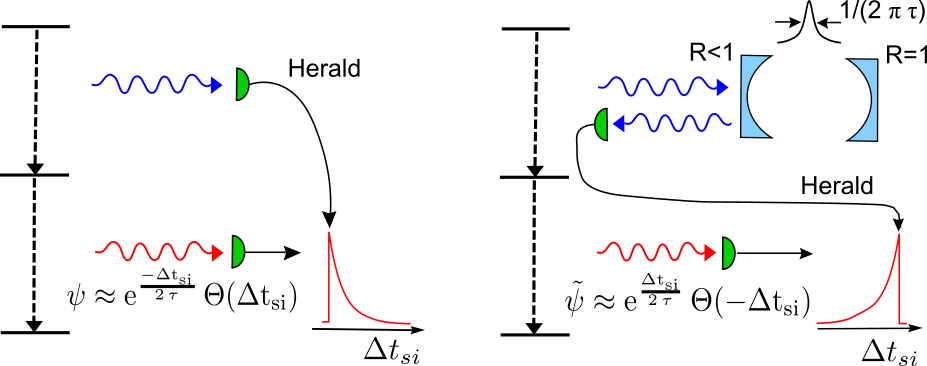
An asymmetric cavity with one mirror of near unit reflectivity converts an incident light pulse with rising exponential temporal shape to a decaying exponential pulse. The time constant of the pulse has to match the cavity ringdown time. Using the cavity with our photon pairs, we obtain a rising exponential shaped single photon resonant with the ground state.
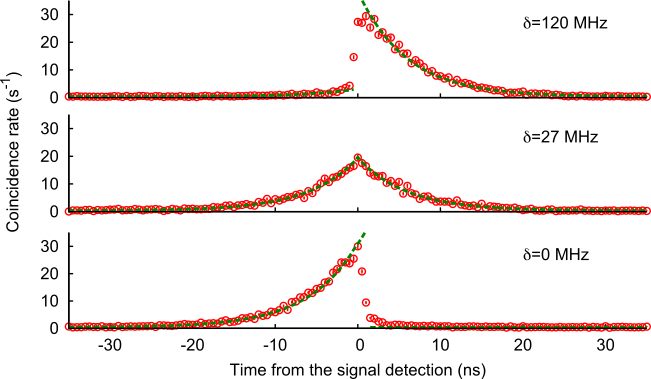
The photon with an exponentially rising envelope is expected to have an enhanced interaction with atomic media. We plan to demonstrate this feature by observing the interaction of this photons with a single atom in free space.
Quantum beats of two decay paths
The source can also be used in collinear configuration, simplifying the alignment of the coupling of the generated photons into single mode fibers. When using 795 nm and 762 nm as pump, photons at 780 nm and 776 nm are generated.
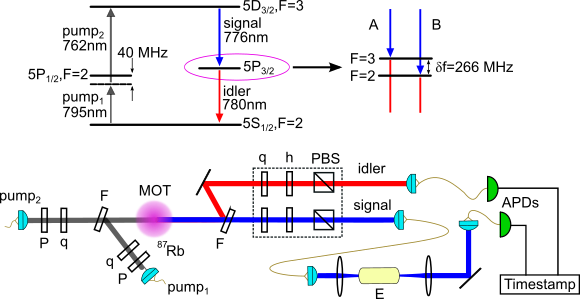
Due to the hyperfine structure of the 5P3/2 intermediate state,
two four-wave mixing process A and B compete.
Each process has a different coherence time due to the different transition
strengths. Together, they provide for polarization-entangled states with a
degree of entanglement depending on the pump polarizations.

The wavelengths of the photons generates by processes A and B differ by 266 MHz, corresponding to the hyperfine separation. This leads to an oscillation in the second order correlation g(2), a signature of quantum beats [9]. The different polarization dependence of decay A and B permits the control of the beat amplitude.
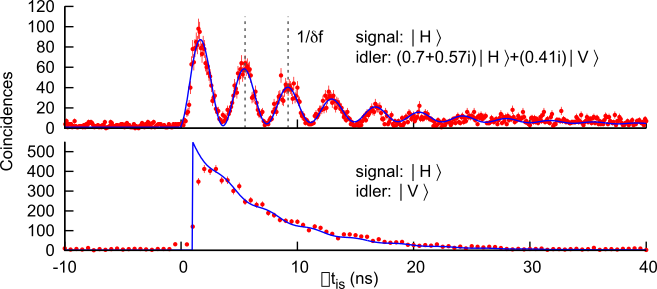
References
| [1] | D.N. Klyshko, Photons and Non-linear optics (1987) |
| [2] | V. Balić et al., Phys. Rev.Lett 94, 183601 (2005) |
| [3] | S. Du et al., Phys. Rev. A 76, 013803 (2007) |
| [4] | R.T.Willis et al., Phys. Rev. A 79, 033814 (2009) |
| [5] | T. Chanelière et al., Phys. Rev. Lett. 96, 093604 (2006) |
| [6] | B. Srivathsan, G.K. Gulati, Chng Mei Yuen Brenda, G. Maslennikov, D. Matsukevich, C. Kurtsiefer, Narrow Band Source of Transform-Limited Photon Pairs via Four-Wave Mixing in a Cold Atomic Ensemble, Phys. Rev. Lett. 111, 123602 (2013) / arXiv:1302.3706. |
| [7] | G.K. Gulati, B. Srivathsan, B. Chng, A. Cerè, D. Matsukevich, C. Kurtsiefer, Generation of an exponentially rising single-photon field from parametric conversion in atoms, Phys. Rev. A 90, 033819 (2014) / arXiv:1402.5800. |
| [8] | B. Srivathsan, G.K. Gulati, A. Cerè, B. Chng, C. Kurtsiefer, Reversing the temporal envelope of a heralded single photon using a cavity, Phys. Rev. Lett. 113, 163601 (2014) / arXiv:1407.8292. |
| [9] | G.K. Gulati, B. Srivathsan, B. Chng, A. Cerè, C. Kurtsiefer, Polarization entanglement and quantum beats of photon pairs from four-wave mixing in a cold Rb-87 ensemble, New Journal of Physics 17, 093034 (2015). |

